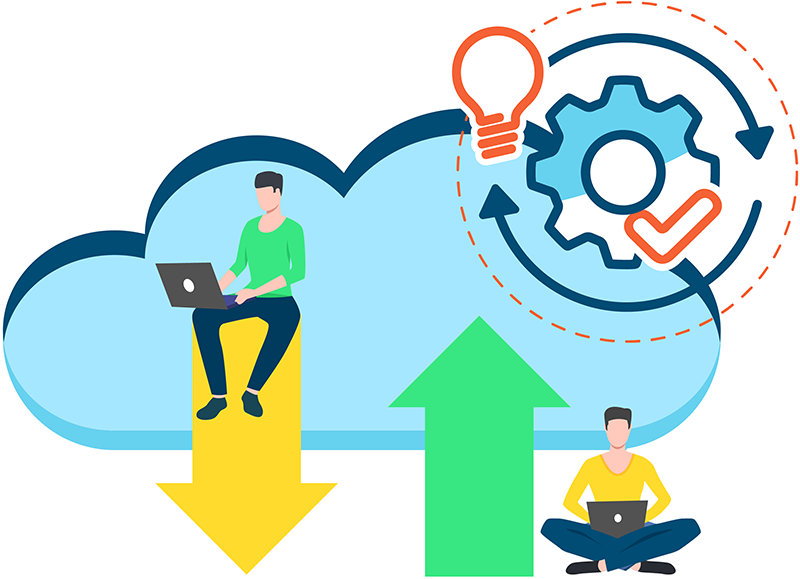Cloud Computing, the delivery of computer system resources over the Internet, has established itself as a robust technology that helps businesses grow, saving money and effort on IT infrastructure. Organizations especially appreciate it for its capabilities to reduce capital costs and expenses while ensuring high-performance and scalability.
Companies often use a combination of public and private cloud solutions, which is called hybrid cloud, and, typically, they have more than one cloud provider – such combination is known as a multicloud.

So far, 92 percent of enterprises have adopted a multi-cloud strategy and 82 percent have adopted a hybrid cloud strategy, Flexera’s State of the Cloud Report claims. The recent trends show that enterprises continue to embrace multi- and hybrid-cloud strategies because of a higher than expected cloud usage due to the COVID-19 outbreak.
What is сloud orchestration?
Just like a conductor leads an orchestra of dozens of musicians, getting them to play together as a single whole, setting the tempo and ensuring correct entries by orchestra members, cloud orchestration coordinates and consolidates automated cloud computing tasks, which results in a consolidated workflow — usually, without human intervention. This can be quite challenging because cloud orchestration involves heterogeneous systems in both public and private clouds, which, since they are often geographically remote, also needs to manage the network that connects them. Without cloud orchestration, this ever-increasing complexity of cloud arrangements cannot be used at its fullest and instead will pose problems that will affect critical data and applications.
Free cloud cost optimization. Lifetime
Cloud orchestration main benefits
We’ve highlighted the main benefits of cloud orchestration above, now let’s plunge deeper into the details.
1. Cost reduction
One of the most obvious advantages of cloud orchestration is potential cost savings. This is achieved primarily by reducing staffing needs due to efficient management of repetitive tasks through automation. Cloud orchestration also promotes economic usage of resources and reduces the cost of infrastructural investments, which results in long-term cost savings.
2. Better visibility
Cloud orchestration provides visibility into resources and processes where mere cloud automation fails to deliver. For instance, an authorized IT specialist is able to monitor and adjust capacity via predefined templates for application deployment and track all the requests and changes being made seamlessly in real-time. All this helps reduce manual work and precious work hours of IT specialists, which also contributes to cost savings.
3. More focus on best practices
It’s obvious that cloud orchestration is hard to implement without knowing and applying best practices, which help properly organize cloud resources and facilitate the deployment process.
4. Improved security
Among other best practices, cloud orchestration software helps IT enterprises easily implement security practices.
5. Optimization capabilities
Cloud orchestration deals with entire workflows rather than single tasks. When these workflows are unified around a set of centralized automation processes, it makes it easier to tweak and upscale automated services, which simplifies optimization.
6. DevOps support
Cloud orchestration supports self-service portals that help users find answers and resolve their issues. It fosters innovation and efficiency across DevOps teams from all over the world.
7. Improved governance
Cloud orchestration enables connections between heterogeneous devices, like cloud-based and on-premises machines, which ensures greater resiliency.
Cloud orchestration vs. cloud automation
A related term for cloud orchestration is cloud automation, and these two terms are used interchangeably – and mistakenly – all too often. First and foremost, cloud automation is all about managing a single task. It can be, for instance, an operating system installation on a server or setting up IAM policies, which define who can log into this web server. Both tasks can be automated but will still require manual intervention in order to be properly executed as a single workload.
Cloud orchestration, on the other hand, involves the coordination of multiple tasks, not just automating the tasks themselves, but also combining distinct tasks into seamless workflows that automate all aspects. Compared to cloud automation, cloud orchestration operates at a higher level of coordination since distinct tasks are already simplified by means of cloud automation.
While there is a substantial difference between cloud automation and orchestration, the latter cannot be realized without the former – simply put, cloud automation is a subcategory, a building block of cloud orchestration.
The importance of cloud orchestration to a cloud migration strategy
At a certain point during the cloud migration process, namely, after the replication to the cloud, it’s necessary to launch applications in the new environment. This should be done in a certain order to ensure data integrity, avoid downtime, and save time. The best way to do this in a proper way is to use a tool that is capable of launching applications with orchestration on a target cloud – conventional test migrations, in contrast, won’t be able to find flaws related to application dependencies.
Conclusion
Wrapping it up, cloud orchestration is a high-level automation that helps create unified, consistent, reliable, error-free, and scalable workflows. It brings numerous benefits to enterprises in general – and IT departments in particular – especially when it comes to cloud migration plan implementation.
Find answers to some of the most frequently asked questions we’ve heard about cloud migration → This FAQ will help you better understand the concepts of cloud migration, as well as its main benefits and challenges.

